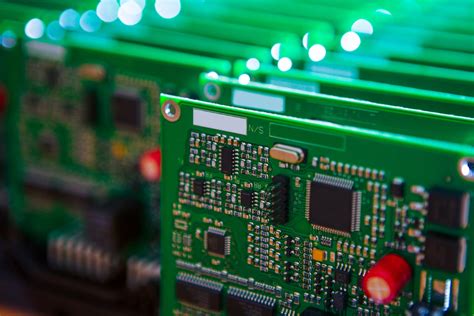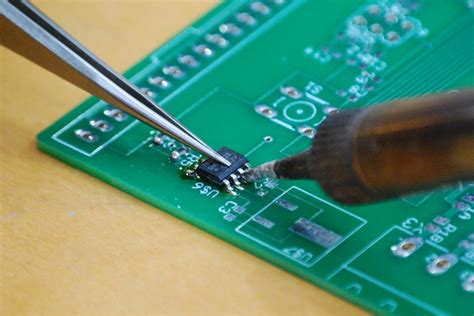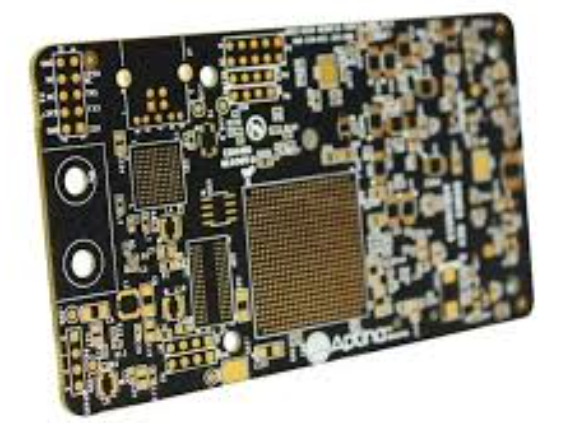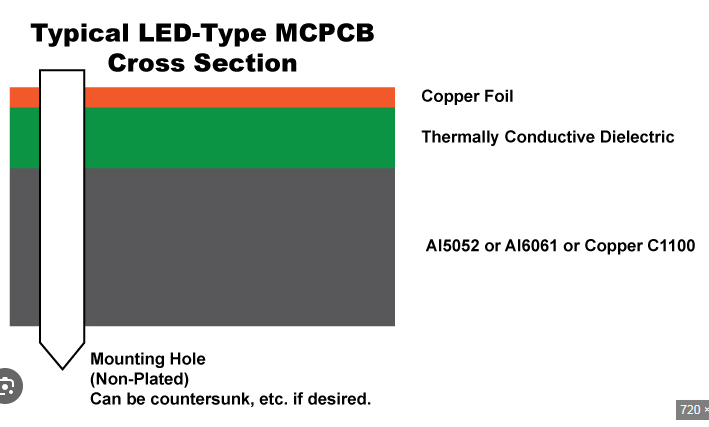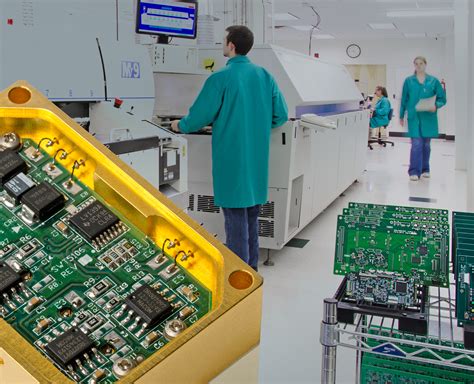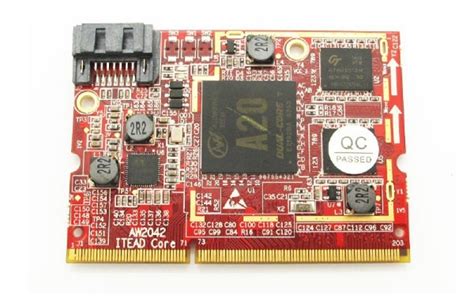Flex pcb base material
Advantages Of Polyimide As A Flex PCB Base Material
Polyimide has emerged as a premier choice for the base material in flexible printed circuit boards (PCBs), owing to its exceptional properties that cater to the demanding requirements of modern electronic applications.
One of the primary advantages of polyimide is its remarkable thermal stability.
Unlike other materials that may degrade or deform under high temperatures, polyimide can withstand extreme thermal conditions, making it ideal for applications that involve significant heat generation or exposure to fluctuating temperatures. This thermal resilience ensures the longevity and reliability of the flex PCBs, even in harsh environments.
In addition to its thermal stability, polyimide exhibits excellent mechanical properties.
Its inherent flexibility allows it to bend, twist, and fold without compromising its structural integrity. This flexibility is crucial for applications where space constraints necessitate the bending or folding of the circuit board, such as in wearable electronics, medical devices, and compact consumer gadgets. The ability to maintain performance under mechanical stress enhances the versatility and applicability of polyimide-based flex PCBs across various industries.
Furthermore, polyimide offers superior chemical resistance, which is essential for ensuring the durability of flex PCBs in environments where they may be exposed to corrosive substances.
This resistance to chemicals, including solvents and acids, protects the circuitry from potential damage, thereby extending the operational life of the device. The robustness of polyimide in the face of chemical exposure makes it a reliable choice for industrial applications where such conditions are prevalent.
Another significant advantage of polyimide as a flex PCB base material is its excellent electrical insulation properties.
Polyimide’s low dielectric constant and high dielectric strength contribute to the efficient performance of the circuit by minimizing signal loss and preventing electrical interference. This characteristic is particularly important in high-frequency applications, where maintaining signal integrity is critical. The electrical insulation properties of polyimide ensure that the flex PCBs can operate effectively in complex electronic systems without compromising performance.
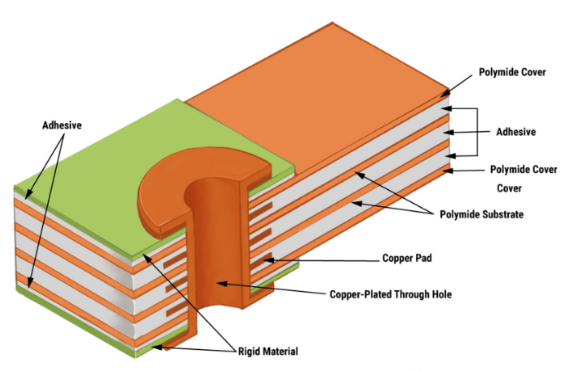
Moreover, polyimide’s compatibility with various fabrication processes adds to its appeal as a base material for flex PCBs.
It can be easily integrated into standard manufacturing techniques, allowing for the production of intricate and high-density circuit designs. This compatibility facilitates the development of advanced electronic devices with enhanced functionality and miniaturization. The ability to support complex designs without sacrificing performance or reliability underscores the versatility of polyimide in the realm of flexible electronics.
In conclusion, the advantages of polyimide as a flex PCB base material are manifold, encompassing thermal stability, mechanical flexibility, chemical resistance, electrical insulation, and fabrication compatibility. These properties collectively contribute to the superior performance and durability of polyimide-based flex PCBs, making them an indispensable component in a wide array of modern electronic applications. As technology continues to evolve, the demand for reliable and high-performance materials like polyimide is likely to grow, further cementing its status as a cornerstone in the development of flexible electronic systems.
Comparing Polyimide And PET For Flexible PCBs
When it comes to the construction of flexible printed circuit boards (PCBs), the choice of base material is a critical factor that significantly influences the performance, durability, and application of the final product. Among the various materials available, polyimide and polyethylene terephthalate (PET) are two of the most commonly used substrates. Each of these materials offers distinct advantages and limitations, making them suitable for different applications. Understanding the comparative attributes of polyimide and PET is essential for making an informed decision in the design and manufacturing of flexible PCBs.
Polyimide is renowned for its exceptional thermal stability, which allows it to withstand high temperatures without degrading.
This characteristic makes polyimide an ideal choice for applications that involve exposure to extreme heat, such as in aerospace, automotive, and industrial sectors. Additionally, polyimide exhibits excellent mechanical properties, including high tensile strength and flexibility, which contribute to its durability and reliability in dynamic environments. The material’s inherent flame resistance further enhances its suitability for safety-critical applications. However, these superior properties come at a higher cost, making polyimide a more expensive option compared to other materials.
In contrast, PET is a more cost-effective alternative that offers a balance of desirable properties for flexible PCB applications.
PET is known for its good electrical insulation properties, which ensure reliable performance in electronic circuits. Moreover, PET provides adequate mechanical strength and flexibility for many standard applications, making it a versatile choice for consumer electronics, medical devices, and other commercial products. While PET does not match the thermal stability of polyimide, it can still perform well in moderate temperature environments. The lower cost of PET makes it an attractive option for applications where budget constraints are a significant consideration.
Transitioning from the material properties to the manufacturing process, it is important to note that both polyimide and PET can be processed using similar techniques, such as roll-to-roll manufacturing.
However, the processing conditions may vary due to the different thermal and mechanical characteristics of the materials. For instance, polyimide requires higher processing temperatures, which can impact the choice of adhesives and other materials used in the PCB assembly. On the other hand, PET’s lower processing temperature can simplify the manufacturing process and reduce energy consumption, contributing to overall cost savings.
Another aspect to consider is the environmental impact of the materials.
Polyimide is generally more resistant to chemical degradation, which enhances its longevity and reduces the frequency of replacements. This durability can be advantageous in reducing electronic waste. Conversely, PET is more susceptible to chemical attack, which may limit its lifespan in harsh environments. However, PET is more easily recyclable compared to polyimide, offering an environmental benefit in terms of material recovery and reuse.
In conclusion, the choice between polyimide and PET as a base material for flexible PCBs depends on a careful evaluation of the specific requirements of the application. Polyimide’s superior thermal stability, mechanical strength, and flame resistance make it suitable for high-performance and safety-critical applications, albeit at a higher cost. PET, with its good electrical insulation properties, adequate mechanical strength, and cost-effectiveness, is well-suited for a wide range of commercial applications where budget constraints are a priority. By considering the material properties, manufacturing processes, and environmental impact, designers and manufacturers can make an informed decision that optimizes the performance and cost-effectiveness of flexible PCBs.
Thermal Management In Flex PCBs: Choosing The Right Base Material
Thermal management is a critical consideration in the design and application of flexible printed circuit boards (flex PCBs). As electronic devices become increasingly compact and powerful, the need to effectively dissipate heat becomes paramount. One of the most crucial factors influencing thermal management in flex PCBs is the choice of base material. Selecting the appropriate base material can significantly impact the performance, reliability, and longevity of the electronic device.
To begin with, polyimide is one of the most commonly used base materials in flex PCBs due to its excellent thermal stability and mechanical properties.
Polyimide can withstand high temperatures, often up to 400°C, without degrading, making it suitable for applications that require high thermal resistance. Additionally, polyimide’s flexibility and durability make it an ideal choice for dynamic applications where the PCB may be subjected to bending and flexing. However, while polyimide offers superior thermal performance, it is also relatively expensive compared to other materials.
In contrast, polyester (PET) is another base material used in flex PCBs, known for its cost-effectiveness and good electrical properties.
Although polyester has a lower thermal resistance compared to polyimide, it can still perform adequately in applications with moderate thermal requirements. Polyester is often used in consumer electronics where cost considerations are paramount, and the thermal demands are not as stringent. However, designers must carefully evaluate the thermal environment to ensure that polyester can meet the specific needs of the application.
Moreover, liquid crystal polymer (LCP) is an emerging base material that offers a unique combination of thermal and electrical properties.
LCP has a low coefficient of thermal expansion, which minimizes the risk of thermal-induced stress and deformation. This material also exhibits excellent moisture resistance, making it suitable for harsh environments. The thermal conductivity of LCP is higher than that of polyimide and polyester, which enhances its ability to dissipate heat efficiently. Consequently, LCP is gaining popularity in high-frequency and high-speed applications where thermal management is critical.
Furthermore, the choice of adhesive used in flex PCBs also plays a significant role in thermal management.
Adhesives such as acrylic and epoxy are commonly used to bond the layers of the PCB. Acrylic adhesives offer good flexibility and thermal resistance, making them suitable for applications with dynamic bending. On the other hand, epoxy adhesives provide superior mechanical strength and thermal stability, which are essential for applications with high thermal loads. The selection of adhesive must align with the thermal and mechanical requirements of the application to ensure optimal performance.
In addition to the base material and adhesive, the overall design and layout of the flex PCB can influence thermal management. For instance, incorporating thermal vias and heat sinks can enhance heat dissipation. Thermal vias are small holes filled with conductive material that facilitate the transfer of heat from the PCB to a heat sink or other cooling mechanism. Proper placement of these thermal management features can significantly improve the thermal performance of the flex PCB.
In conclusion, choosing the right base material for flex PCBs is a multifaceted decision that requires careful consideration of thermal, mechanical, and cost factors. Polyimide, polyester, and liquid crystal polymer each offer distinct advantages and limitations that must be weighed against the specific requirements of the application. Additionally, the choice of adhesive and the overall design of the PCB play crucial roles in effective thermal management. By thoroughly evaluating these factors, designers can ensure that their flex PCBs perform reliably and efficiently in their intended applications.
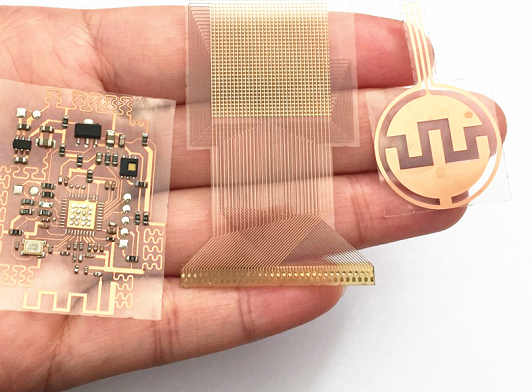
Environmental Impact Of Different Flex PCB Base Materials
The environmental impact of different flex PCB base materials is a critical consideration in the electronics industry, as the demand for flexible printed circuit boards (PCBs) continues to rise. Flex PCBs are integral to various applications, including consumer electronics, medical devices, and automotive systems, due to their lightweight, flexible, and durable nature. However, the choice of base material significantly influences the environmental footprint of these components. Understanding the ecological implications of different materials can guide manufacturers in making more sustainable choices.
Polyimide is one of the most commonly used base materials for flex PCBs.
Known for its excellent thermal stability, mechanical strength, and chemical resistance, polyimide is highly favored in high-performance applications. However, the production of polyimide involves the use of hazardous chemicals and solvents, which can lead to environmental pollution if not managed properly. Additionally, the energy-intensive manufacturing process contributes to greenhouse gas emissions. Despite these drawbacks, polyimide’s durability and long lifespan can offset some environmental impacts by reducing the frequency of replacements and waste generation.
Another widely used material is polyester, which offers a cost-effective alternative to polyimide.
Polyester-based flex PCBs are suitable for less demanding applications where extreme thermal and mechanical properties are not required. The production of polyester is generally less energy-intensive compared to polyimide, resulting in lower carbon emissions. However, polyester is derived from petroleum, a non-renewable resource, and its disposal poses environmental challenges. Polyester is not biodegradable and can contribute to plastic pollution if not properly recycled.
Liquid crystal polymer (LCP) is an emerging material in the flex PCB industry, known for its exceptional electrical properties and low moisture absorption.
LCPs are increasingly being used in high-frequency and high-speed applications. The environmental impact of LCPs is relatively lower compared to polyimide, as their production involves fewer hazardous chemicals. However, the extraction and processing of raw materials for LCPs still pose environmental concerns. Moreover, the recycling of LCP-based PCBs is complex due to the material’s unique properties, which can hinder efforts to minimize electronic waste.
In recent years, there has been a growing interest in developing eco-friendly alternatives to traditional flex PCB base materials.
One such innovation is the use of biodegradable polymers, which can significantly reduce the environmental impact of electronic waste. These materials are designed to break down naturally over time, minimizing their contribution to landfill and pollution. However, biodegradable polymers currently face challenges in terms of performance and durability, limiting their widespread adoption in high-performance applications.
To mitigate the environmental impact of flex PCB base materials, manufacturers can adopt several strategies.
Firstly, improving the efficiency of production processes can reduce energy consumption and emissions. Secondly, implementing robust waste management and recycling programs can minimize the environmental footprint of discarded PCBs. Additionally, investing in research and development of sustainable materials can pave the way for greener alternatives in the future.
In conclusion, the environmental impact of different flex PCB base materials varies significantly, with each material presenting unique challenges and opportunities. Polyimide, polyester, and liquid crystal polymer each have distinct ecological footprints influenced by their production processes, raw material sourcing, and end-of-life disposal. As the electronics industry continues to evolve, prioritizing sustainability in material selection and manufacturing practices will be crucial in reducing the environmental impact of flex PCBs. By embracing innovative solutions and adopting responsible practices, the industry can contribute to a more sustainable future.

